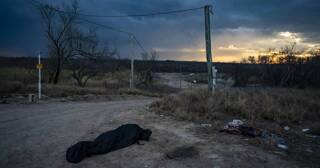Harvard: How the Media Partnered With Hezbollah
During Israel’s war against Hizballah, at LGF we were continually outraged by the media’s uncritical promulgation of terrorist propaganda, and their overwhelming bias against Israel. The barrage of staged and manipulated disinformation culminated in the infamous Adnan Hajj fauxtography incident; and it can be argued that the culture of tacit cooperation with terrorists was at least partly responsible for that stunning case of phony news.
How could Reuters’ experienced editors miss a fake picture that was so bleeding obvious, at every step of the way toward publication? Answer: because they just didn’t care.
It’s interesting that in an age of obsessive media focus on scandals, no wire service or newspaper has ever followed up on that story in any real way. Adnan Hajj seemed to simply vanish off the face of the earth; no interviews, no photos of him, no investigations, just one statement—reported by Reuters—in which he claimed his fakery was to “remove dust,” then poof! Adnan who?
For blowing the whistle on Hizballah’s manipulation of Reuters, LGF was smeared by numerous leftists; the diversionary tactics ranged from personal attacks to attempts to minimize the importance of the faked photos.
Now the Harvard Shorenstein Center on the Press, Politics and Public Policy, hardly a bastion of neocon wingnut thinking, has issued a paper that absolutely skewers the media for their outrageously biased and terrorist-enabling behavior. Maybe this will be a little harder for them to ignore: How the Media Partnered With Hezbollah: Harvard’s Cautionary Report.
While the war between Israel and Hezbollah raged in Lebanon and Israel last summer, it became clear that media coverage had itself started to play an important role in determining the ultimate outcome of that war. It seemed clear that news coverage would affect the course of the conflict. And it quickly transpired that Hezbollah would become the beneficiary of the media’s manipulation.
A close examination of the media’s role during the 2006 Israel-Hezbollah war in Lebanon comes now from Harvard University’s Kennedy School of Government, in an analysis of the war published in a paper whose subtitle should give pause to journalists covering international conflict: “The Israeli-Hezbollah War of 2006: The Media as a Weapon in Asymmetrical Conflict.” Bernard Kalb [note: actually, it’s Marvin Kalb. —ed.], of Harvard’s Shorenstein Center on the Press, Politics and Public Policy, methodically traces the transformation of the media “from objective observer to fiery advocate.” Kalb painstakingly details how Hezbollah exercised absolute control over how journalists portrayed its side of the conflict, while Israel became “victimized by its own openness.”
The lessons from the Harvard paper go well beyond historic analysis. Kalb’s thoroughly and persuasively documented case points to the challenges to journalists in future “asymmetrical” conflicts in which a radical militia provides access only to journalists agreeing to the strictest of rules.
Journalists did Hezbollah’s work, offering little resistance to the Islamic militia’s effort to portray itself as an idealistic and heroic army of the people, facing an aggressive and ruthless enemy. With Hezbollah’s unchallenged control of journalists’ access within its territory, it managed to almost completely eliminate from the narrative crucial facts, such as the fact that it deliberately fired its weapons from deep within civilian population centers, counting on Israeli forces to have no choice but defend themselves by targeting rocket launchers where they stood. Hezbollah’s strong support from Syria and Iran — including the provision of deadly weapons — faded in the coverage, as the conflict increasingly became portrayed as pitting one powerful army against a band of heroic defenders of a civilian population.
Gradually lost in the coverage was the fact that the war began when Hezbollah infiltrated Israel, kidnapping two of its soldiers (still held to this day) and killing eight Israelis. Despite the undisputed fact that Hezbollah triggered the war, Israel was painted as the aggressor, as images of the war overtook the context.
UPDATE at 4/25/07 10:20:33 am:
Here’s the full report, in PDF form.












